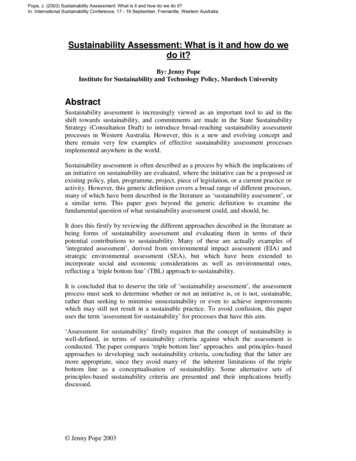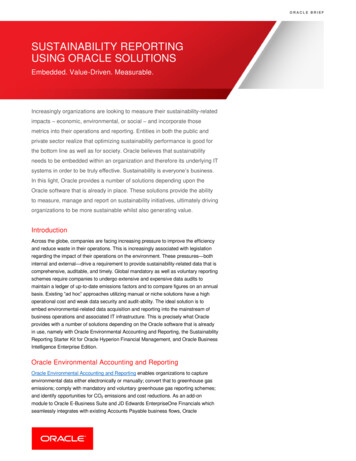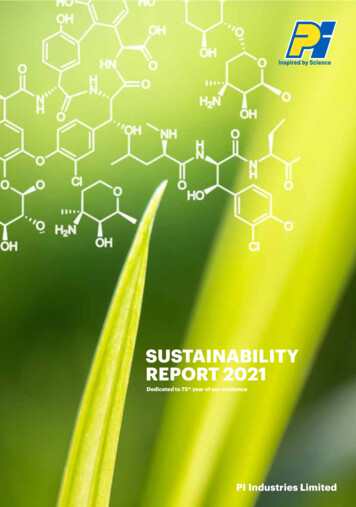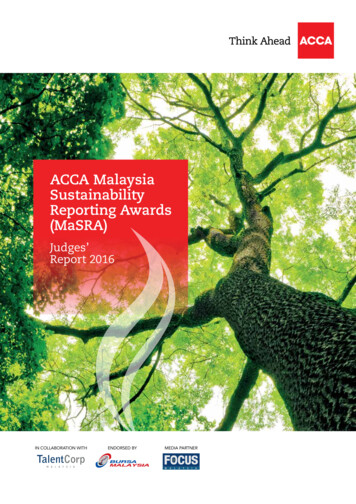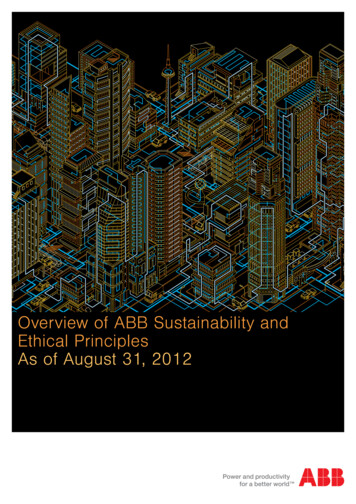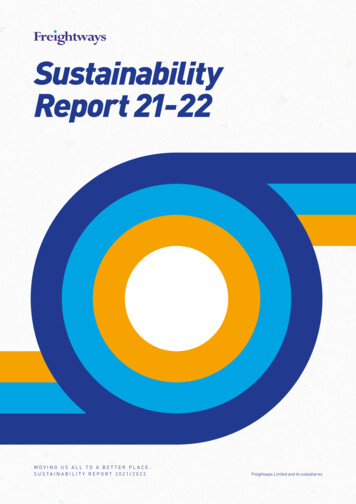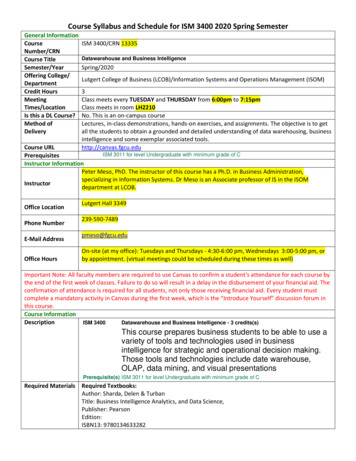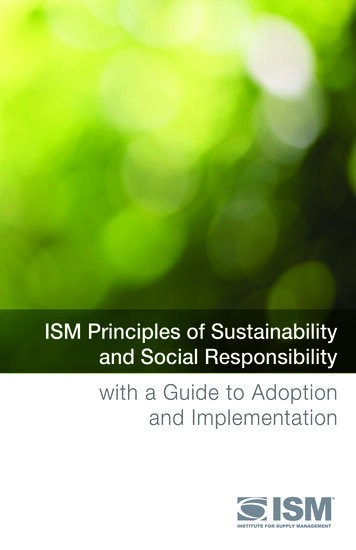
Transcription
ISM Principles of Sustainabilityand Social Responsibilitywith a Guide to Adoptionand Implementation
Published by:Institute for Supply Management , Inc.Thomas W. Derry, Chief Executive Officer 2016Institute for Supply Management 309 W. Elliot Road, Suite 11Tempe, AZ 85284USAwww.instituteforsupplymanagement.orgAll rights reserved. Material may be copied and used with permission, with credit given to ISM.Printed in the United States of America.
Dear Supply Management and Business LeadersISM has a proud history of establishing and advancing global standards forthe supply management profession.In an important continuation of our tradition of professional leadership, theISM Board of Directors approved important updates to the ISM Principlesof Sustainability and Social Responsibility in October 2015. The ISMCommittee on Sustainability and Social Responsibility deserves thanksfor its commitment and leadership, ensuring the principles and standardsrepresent our modern business environment.I call your attention to these eleven statements because each day, at leastone of these principles is prominently featured in the news. The principlesaddress conditions that are far too prevalent in today’s complex globalsupply networks, whether the issue is safety, as highlighted by the 2013collapse of a textile factory in Bangladesh, or environmental protection,including, for example, the consumption of scarce water resources in thesupply chain.As consumers, governments and other organizations focus more attentionon these issues in the future, the ISM Principles of Sustainability and SocialResponsibility will only grow in importance as a global standard for ourprofession. With the ISM principles as our foundation, our profession isuniquely positioned to make sure that doing good is also good business.Sincerely yours,Thomas W. DerryCEOInstitute for Supply Management 1
ISM PRINCIPLES OF SUSTAINABILITYAND SOCIAL RESPONSIBILITYAdopted by the ISM Board of Directors, 20151. Anti-corruptionDo not tolerate corruption in any form.2. Diversity & InclusionPromote diversity and inclusion throughout the organization and the supply chain.3. Environment Support environmental precaution, promote environmental responsibility andencourage environmentally friendly technologies and processes.4. Ethics & Business Conduct Behave ethically always and demand ethical conduct within the organization andthroughout the supply chain.5. Financial IntegrityConduct all financial business dealings and decision-making with integrity.6. Global Citizenship Act (in person and virtually) for the benefit of all global citizens, locally and elsewhere,fulfilling ethical and moral obligations.7. Health & Safety Protect persons in the supply chain from the risk of injury, danger, failure, error, harmand/or loss of life.8. Human Rights Recognize and acknowledge that human beings have universal and natural rightsand status regardless of legal jurisdiction and local factors.9. Labor Rights Respect, promote and protect an individual’s labor rights as defined by applicableinternational conventions.10. Supply Chain Sustainability Support supplier development of more sustainable business practices, products andservices and the embedding of sustainability throughout supply chains.11. Transparency Make available full and complete information necessary for collaboration,cooperation and collective decision-making. Require a corresponding level oftransparency from suppliers and throughout the supply chain.2
INTRODUCTIONISM Sustainability and Social Responsibility MissionIt is part of the mission of Institute for Supply Management to foster and drive sustainabilityand social responsibility excellence across the supply chain through the development andcommunication of principles and guidance and the sharing of tools, information and bestpractices.Definitions of Sustainability, Social Responsibility and Related PrinciplesSustainability: Sustainability is the ability to meet current needs without hindering the abilityto meet the needs of future generations in terms of economic, environmental and socialchallenges.Social Responsibility: Social responsibility is a commitment by a business to act ethically andcreate benefit for the workforce, the local community and society.ISM Principles of Sustainability and Social Responsibility: The ISM Principles of Sustainabilityand Social Responsibility collectively define the scope of issues that are considered within thecontext of sustainability and social responsibility in the supply chain. The Principles cover anticorruption, diversity and inclusion, environment, ethics and business conduct, financial integrity,global citizenship, health and safety, human rights, labor rights, supply chain sustainability, andtransparency.The Importance of Supply Management to Sustainability and SocialResponsibilityThe supply management business function is critical to any organization’s success inimplementing policies, processes and practices that improve sustainability and socialresponsibility. From a legal and risk perspective, the supply management function must ensurethat companies within their supply chains are not engaging in illegal, unethical or harmfulpractices to either people or the environment. This responsibility extends to all tiers of theupstream supply chain, not just immediate suppliers. From a business opportunity perspective,supply managers can positively incentivize suppliers to improve their sustainability and socialresponsibility, and work with them to improve their capabilities. This can lead to additionalbusiness benefits of reduced cost, increased access to markets/buyers, and better recruitmentand retention of talent.Although many companies have attended to sustainability and social responsibility withintheir own operations, fewer have engaged their supply chain. This leaves many risks andopportunities unaddressed. In fact, for any given company, many and sometimes most of itsenvironmental and social impacts exist upstream, embedded in the products and servicespurchases and the business practices of its suppliers. This makes it all the more important fora company’s supply management organization to lead efforts that contribute to the company’sbroader sustainability and social responsibility objectives. In turn, suppliers should be heldaccountable for working with their own suppliers towards sustainability improvement, andthose second-tier suppliers with their suppliers, and so on. In this manner, the entire supplychain is engaged.3
Supply management professionals are challenged with difficult decisions involving sustainabilityand social responsibility. For example, Should a company avoid sourcing from a region where the risk of child labor is high, orshould it incur the cost of inspection and certification? If packaging material impacts are significant, should packaging weight be reduced at therisk of decreasing product safety during transportation? Should a company disclose its list of suppliers, or will this put those suppliers at risk fortargeting by activist stakeholders?There are rarely simple answers, and because of the global nature of supply chains, localregulations, markets and culture must be taken into account. Unlike other areas of businesswhere best practices are universal, the best solution for a sustainability and social responsibilityissue may be highly contextual and even change over time.For that reason, the supply management professional must be grounded in a set of principlesthat can be applied across many situations and contexts — principles that lead the professionalin the direction of making a sound decision.These principles are also meant to serve as a call to action. Best-in-class organizations insustainability and social responsibility incorporate specific and measurable practices acrosstheir supply chains. In this context, the Sustainable Purchasing Leadership Council, which isa leader in defining aspects of sustainable procurement, suggests purchasing leaders should:1) Understand the relevant environmental, social and economic impacts of theirorganization’s purchasing.2) Take responsibility for the relevant environmental, social and economic impacts oftheir purchasing by committing to an action plan.3) Deliver on their commitment to improve the relevant environmental, social andeconomic impacts of their purchasing.4)Actively promote internal and external innovation that advances a positive future.5)Solicit and disclose information that supports a marketplace of innovation.In moving from awareness to action, supply management professionals need to educatethemselves about relevant initiatives, best practices, standards, international and regionalbusiness regulations and context, and trends within their own industry. Some useful referencesare provided at the end of this document.4
PRINCIPLES, RESPONSIBILITIES,POLICIES AND METRICSThe ISM Principles of Sustainability and Social Responsibility are designed to enable bothindividual supply managers and the supply organization as a whole to customize a frameworkspecific to industry and supplier needs. The content provided herein will need to be integratedinto existing organizational frameworks for sourcing, procurement and supplier relationshipmanagement. Well-managed integration is essential; sustainability and social responsibilityshould not be seen solely as a “bolt on” to supply management. Statements and content arenot all encompassing but provide a solid foundation to express important characteristics ofeach principle. Often a statement for one principle may be applicable to others.In this section, each of the eleven Principles is described in four parts:1)A statement of the general principle.2)A description of responsibilities of a supply management organization.3)A description of responsibilities of a supply management professional.4)A list of possible policies, programs and performance metrics.The development and implementation of metrics and performance criteria is a critical andbest practice to the success of sustainability and social responsibility initiatives. Integratingindividual and business goals and objectives with relevant measurements will ensure the abilityto track and report progress and determine where additional time and resources are required.Supply professionals must consider impact, influence, and positioning when selecting anddeveloping metrics to embed throughout (1) the supply organization, (2) the organizationand (3) the broader supply base. Metrics will typically be stated in absolute numbers, as apercentage, by employee, in ratios, or in other ways that allow for effective comparison anddata management.5
1. Anti-corruptionGeneral PrincipleDo not tolerate corruption in any form.Responsibilities of Supply Management OrganizationEstablish clear policies for employees, suppliers and the extended supply chain (1) definingcorruption and (2) clearly stating the organization’s position regarding corruption. Comply —and, whenever possible, exceed compliance — with all local and international anti-corruptionlaws and protocols. Provide employee training and other organizational support to assist inimplementation of anti-corruption practices in the supply chain.Responsibilities of Supply Management ProfessionalUniformly communicate organizational policies regarding corruption to all suppliers andthroughout the supply chain. Do not engage in any form of corruption. Discontinue businessrelationships with any supply chain partner that participates in any form of corruption.Representative Policies, Programs and Metricsa) Due diligence internally, with suppliers and across the supply chainb) Good conduct guidelinesc) Investigative and audit capabilitiesd) Number or rates of items reported to corporate compliancee) Reporting structures in place for assuring compliancef) Subscription and/or membership with affiliated organizations (for example, The UnitedNations Global Compact)g) Training completion rates2. Diversity & InclusionGeneral PrinciplePromote diversity and inclusion throughout the organization and the supply chain.Responsibilities of Supply Management OrganizationFoster and engage a diverse group of employees, external partners, suppliers and affiliates.Provide organizational resources and develop and implement practices that identify anddevelop supply management employees and suppliers from diverse and underrepresentedpopulations.Responsibilities of Supply Management ProfessionalAccept and welcome employees, external partners, suppliers and affiliates of all backgrounds.Develop and use hiring and supplier selection practices that identify, retain and cultivate diverseemployees and suppliers.Representative Policies, Programs and MetricsWorkforce diversity and inclusion fosters the attraction and retention of a workforce thatreasonably represents the customer and communities in which the organization operates;accordingly, the following measures of the process and resulting employee makeup are relevant:a) Employee demographic mix across the organization and within organization levels (forexample, ethnicity and gender)b) Promotion and executive movement6
c) Provisions for disabilities and special needsd) Recruiting resultse) Retention and promotion rates, if applicable.Attraction and retention of a diverse supply base is the responsibility of each supplyprofessional; the following process measures apply:a) Adoption of principles advocating value-add beyond diversity (such as hard or soft costsavings, innovation, superior quality and customer service)b) Compensation of employees linked to achievement of diversity goalsc) Distribution of supplier diversity across varied dimensions (for example, indirect vs. direct,small vs. large, commodity groups)d) Percent of spend allocated to diverse supplierse) Supplier diversity trainingf)Supplier diversity policies and measurement programs3. EnvironmentGeneral PrincipleSupport environmental precaution, promote environmental responsibility and encourageenvironmentally friendly technologies and processes.Responsibilities of Supply Management OrganizationComply — and, whenever possible, exceed compliance — with all applicable environmentallaws, regulations and protocols. Develop and implement environmentally friendly practicesthroughout the supply chain. Provide employees with the training and resources needed tomake environmentally conscious supply management decisions.Responsibilities of Supply Management ProfessionalCommunicate, deploy and enforce the organizational commitment to environmentalresponsibility through contractual documentation, supplier relationship management practicesand supplier development plans. Engage with supply chain stakeholders in environmentalresponsibility.Representative Policies, Programs and Metricsa) Biodiversity-focused concepts, policies and practicesb) Buildings and construction policy and practices (for example, LEED Certification, GreenGlobes, Energy Star, etc.)c) Certifications and awards, use of (for example, ISO 14000, SA8000, InternationalOrganization for Standardization, Social Accountability International and AmericanSociety for Quality)d) Certified sources, use ofe) Climate protection initiativesf)Commodity and raw material consumption (renewable, nonrenewable, bio-based, etc.)g) Consortia participation (for example, AIAG, EICC, GEMI, TSC, etc.)h) Deforestation policies and practicesi)Disposal and waste management policies and practicesj)Education and communication initiatives7
k) Energy consumption (power, natural gas, electric (including reduction), alternative energygeneration and consumption, in plants, offices, warehouses, etc.) Baseload sources (for example, coal, hydrothermal and nuclear) Intermittent sources (for example, wind and solar)l)Energy sources (natural gas, coal, oil, wind, geothermal, etc.)m) Fuel consumption (diesel, gasoline, natural gas and oil)n) Heat generationo) IT and print fleet policies and practices (for example, Energy Star and the implementationof print lifecycle management software)p) Land use (sustainable agriculture, etc.), soil erosion management programsq) Landfill content reduction and/or zero waste initiativesr)Material toxicitys) Noise pollutiont)Offset policies and programsu) Packaging reduction initiatives Design (including size reduction) Eco-friendly materials/biodegradables (glues, inks, papers, etc.)v) Paper and paper product consumption, reduction, recycling, etc. (for example, ForestStewardship Council, Sustainable Forestry Initiative and the Programme for theEndorsement of Forest Certification)w) Particulate matter (PM) emissionsx) Product design, durability, disassembly, content (including disclosure of materials inproducts and product design)y) Scopes 1, 2 and 3 greenhouse gas (GHG) emissions inventories Business travel Facility consumption and impacts Logistics consumption and impacts Worker commutes Value chain consumption and impactsz) Transportation and logistics management programs and practices, including routingand consolidation, fleet management (for example, US EPA SmartWay, hybrid trucks,truckload utilization and alternate fuels)aa) Travel policies and data (for example, miles driven, miles flown and nights away fromhome base)bb) Upcycling programs and practices (for example, product reclamation and reuse)cc) Water conservation, consumption, recycling, treatment4. Ethics & Business ConductGeneral PrincipleBehave ethically always and demand ethical conduct within the organization and throughoutthe supply chain.8
Responsibilities of Supply Management OrganizationProvide employees with ethics and business conduct training and clear conflict-of-interest policyguidelines. Encourage employees to report any policy violations and provide whistleblowerprotection consistent with best practices for those who come forward.Responsibilities of Supply Management ProfessionalComplete ethics and business conduct training. Agree to and abide by policy guidelines,including applicable conflict-of-interest policies. Report any and all suspected policy violations.Representative Policies, Programs and Metricsa) Adoption of the ISM Principles and Standards of Ethical Supply Management Conductb) Anti-influence-peddling policies and trainingc) Audit and accounting issues, practices for identifying and remediatingd) Business conduct inquiries (by employees, suppliers and others)e) Conduct provisions in supplier contracts and subsequent monitoringf)Employee and supplier training completion or participation ratesg) Ethical sourcing and practices definedh) Ethics and conduct actively explored during job interviews/hiringi)Ethics hotline and other reporting channels used (for example, audits, etc.)j)Executive-level ethics/governance committeek) Process for addressing allegations of improprietyl) Regular communication with suppliers regarding ethical business conduct expectationsand performancem) Sourcing decisions documentedn) Suppliers required to formally sign ethical sourcing and practice policyo) Types and numbers of disciplinary actions taken (counseled, oral warning, writtenwarning, termination, resignation)p) Written code of conduct established in place and communicated5. Financial IntegrityGeneral PrincipleConduct all financial business dealings and decision-making with integrity.Responsibilities of Supply Management OrganizationSafeguard financial information against internal and external threats. Document all transactionsaccording to best practices for financial reporting and data security.Responsibilities of Supply Management ProfessionalEnsure protection of supplier and internal financial information and data. Comply withappropriate policies, laws and regulations.Representative Policies, Programs and Metricsa) Adherence to accounting principles and standards issued by governance andgovernmental entities9
b) Adoption of risk management practices Business continuity planning Disaster recovery measures Alternate supply sources identifiedc) Alignment with UN Principles for Responsible Investmentd) Publication of internal policies and guidelinese) Supplier financial health6. Global CitizenshipGeneral PrincipleAct for the benefit of all global citizens, locally and elsewhere, fulfilling ethical and moralobligations.Responsibilities of Supply Management OrganizationStrive to add value to society by investing in and supporting local communities and communityfocused initiatives where supply chain activities take place.Responsibilities of Supply Management ProfessionalParticipate in community initiatives on behalf of the company. Cultivate and share opportunitiesfor community involvement.Representative Policies, Programs and Metricsa) Corporate and/or foundation donations of products and servicesb) Employee financial contributionsc) Employee volunteerism Organization-sponsored employee leave-of-absence programs to volunteer outsideof local community Hours or personal days provided to employees for community initiativesd) Evaluation of business decisions in context of community impacte) Funding of citizen-based initiativesf)Indigenous programs and supportg) In-kind contributionsh) Number and types of programs in place, including philanthropy and foundationresources/giving7. Health & SafetyGeneral PrincipleProtect persons in the supply chain from the risk of injury, danger, failure, error, harm and/orloss of life.Responsibilities of Supply Management OrganizationProvide employees with a safe and healthy environment. Prioritize safety throughout thesupply chain. Meet or exceed applicable health and safety laws and regulations.10
Responsibilities of Supply Management ProfessionalWork to continuously improve the safety of processes being used and products andservices being offered or under development. Communicate organizational health and safetyexpectations to suppliers and throughout the supply chain.Representative Policies, Programs and Metricsa) Accidents and injury ratesb) Audit non-conformance rates related to health and safetyc) Cafeteria compliance with safety and health regulationsd) Employee housing safety and structural compliancee) Health and wellness initiatives and programsf)Illness prevention measuresg) Product safety accomplishments and recognitionh) Provision of safety and ergonomic equipment (for example, eyewear, ear plugs, gloves,and hard hats)i)Published supplier code of conductj)Working conditions (for example, air conditioning, heat, lighting and ventilation)k) Written safety procedures, documented audits8. Human RightsGeneral PrincipleRecognize and acknowledge that human beings have universal and natural rights and statusregardless of legal jurisdiction and local factors.Responsibilities of Supply Management OrganizationSupport and uphold human rights both domestically and abroad. Abide by applicable humanrights protocols. Create and articulate clear policies and expectations regarding the protectionof human rights throughout the supply chain.Responsibilities of Supply Management ProfessionalTreat all people with dignity and respect. Communicate organizational human rights policiesand expectations to suppliers and throughout the supply chain. Be vigilant as to possiblehuman rights violations in the supply chain. Implement appropriate organizational policies andprocedures upon learning of suspected abuse.Representative Policies, Programs and Metricsa) Child labor, slavery and human trafficking policies and practicesb) Commitment to implement UN Guiding Principles on Business and Human Rightsc) Compensation and wage policies (for example, local and living wage concept)d) Compliance with relevant local laws and regulationse) Conduct human rights risk assessments on company operations, suppliers by keygeographies or product linesf)Freedom of association policies and practicesg) Indigenous people policies and practicesh) Published human rights policyi)Signatory to United Nations Global Compact11
j)Training and development on business responsibility to respect human rightsk) Working hoursl)Workplace culture, environment and conditions9. Labor RightsGeneral PrincipleRespect, promote and protect an individual’s labor rights as defined by applicable internationalconventions.Responsibilities of Supply Management OrganizationSupport freedom of association and right to collective bargaining. Reject forced labor and childlabor. Create clear policies regarding labor rights applicable to suppliers and throughout thesupply chain.Responsibilities of Supply Management ProfessionalDo not discriminate with respect to occupation or employment. Communicate organizationallabor rights policies and expectations to suppliers and throughout the supply chain. Be vigilantas to possible labor rights violations. Implement appropriate organizational policies andprocedures upon learning of suspected violation.Representative Policies, Programs and Metricsa) Representative policies, programs and metrics in adherence to International LaborOrganization principles and guidelinesb) Audit non-conformance rates by key labor categoriesc) Child labor policies and practicesd) Compensation and wage policies and practices (for example, local and living wageconcept)e) Compliance with relevant local laws and regulationsf)Description of supplier monitoring and evaluation processes and programsg) Freedom of association policies and practicesh) Published supplier code of conducti)Signatory to United Nations Global Compactj)Supplier training and developmentk) Working hours10. Supply Chain SustainabilityGeneral PrincipleSupport supplier development of more sustainable business practices, products and servicesand the embedding of sustainability throughout supply chains.Responsibilities of Supply Management OrganizationDevelop supplier-facing sustainability goals that address environmental, social and financialperformance in the supply chain context. Work with partners throughout the supply chain todevelop and deploy consistent and complementary sustainability goals.12
Responsibilities of Supply Management ProfessionalCommunicate organizational sustainability policies and expectations to suppliers andthroughout the supply chain. Hold suppliers accountable to sustainability goals and track theirprogress and performance. Encourage and (whenever possible) assist suppliers to developtheir own sustainability goals.Representative Policies, Programs and Metricsa) Contact information for chief sustainability officer (or equivalent) publicly availableb) Creation and measurement of supplier sustainability goalsc) Inclusion of the following topics in metrics: responsible sourcing, recycling, end-of-lifemanagement, transparency of supply chain, disclosure of substances of concern, riskmanagementd) Incorporation of sustainability commitments in purchasing documents (for example,purchase order, general terms and conditions, and request for quote)e) Published supplier code of conductf)Results of supplier sustainability assessments and auditsg) Supplier engagement mechanisms, such as supplier advisory councils and sustainabilitywork teamsh) Supplier sustainability training11. TransparencyGeneral PrincipleMake available full and complete information necessary for collaboration, cooperation andcollective decision-making. Require a corresponding level of transparency from suppliers andthroughout the supply chain.Responsibilities of Supply Management OrganizationWhile taking into account proprietary considerations, develop and deploy policies andpractices that are open and transparent to relevant internal and supply chain stakeholders.Whenever practicable, measure and publicly report relevant targets, timelines and progresstoward organizational goals.Responsibilities of Supply Management ProfessionalCommunicate organizational policies and expectations regarding transparency in supply chainrelationships and business dealings to suppliers and throughout the supply chain. Promotesupplier adoption of transparent supply chain management and business practices.Representative Metricsa) Disclosure of supply chain-related risks to investors and other stakeholdersb) Disclosure of supplier locationsc) Knowledge of growing or sourcing regions for raw materialsd) Public corporate sustainability reporting policies and practicese) Release of third-party audits and certification13
FOR FURTHER READINGBusiness and SustainabilityCradle to Cradle: Remaking the Way We Make ThingsW. Braungart and W. McDonough (2002), North Point Press.Green Giants: How Smart Companies Turn Sustainability into a Billion Dollar BusinessE.F. Williams (2015), AMACOM.Natural Capitalism: Creating the Next Industrial RevolutionP. Hawken (1990), NY: Little Brown and Company.General Sustainability ReferencesTransforming Our World: the 2030 Agenda for Sustainable DevelopmentUnited Nations, nsformingourworldThe UN Sustainable Development Goals (SDGs) are the most broadly adopted such setwithin the global business community.United Nations Environment Program (UNEP)United Nations, http://www.unep.org/. UNEP creates broadly adopted environmentalprinciples and standards.United Nations Global Compact (UNGC)United Nations, http://www.unep.org/. UNGC is “a call to companies to align strategies andoperations with universal principles on human rights, labor, environment and anti-corruption,and take actions that advance societal goals.”Sustainable Performance StandardsEnvironmental, Health, and Safety GuidelinesInternational Finance Corporation/World Bank,http://www.ifc.org/wps/wcm/connect/topics ext content/ifc external corporate site/ifc sustainability/our approach/risk management/ehsguidelinesThe EH&S Guidelines from IFC/World Bank identify general and sector-specific standards forperformance.International Labour Organization Core Labour Conventions and Standards InternationalLabour Organi
The Importance of Supply Management to Sustainability and Social Responsibility The supply management business function is critical to any organization's success in implementing policies, processes and practices that improve sustainability and social responsibility. From a legal and risk perspective, the supply management function must ensure



